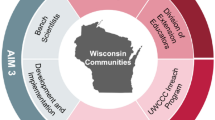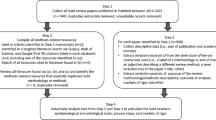Abstract
This study was conducted as a needs assessment to inform the development of an educational program designed to provide mentorship and skills supporting careers in cancer research, with a focus on domestic minority populations and international settings. The objectives were to determine: (1) the level of interest among trainees in careers in cancer research and (2) preferences and constraints constituted by potential components, features, and duration of the proposed extramural training program. The target populations were participants and directors of federal training programs in cancer research, specifically (1) trainees in the NCI—K01, K07, and K08 programs, as well as the Department of Defense (DoD) Breast and Prostate Control Programs and (2) PIs of NCI R25 training programs and federally designated Comprehensive Cancer Centers. We developed, piloted, and administered electronically a survey to elicit perspectives of trainees’ career development needs and preferences. Response rates from each training group exceeded 65%, with the exception of the K08 trainees (49%). The proportion of cancer research trainees who are interested in careers that include research on US minority groups was 70% of K01 trainees, 72% of K07 trainees, 45% of K08 trainees, and 75% of DoD trainees. A substantial percent of these trainees indicated their plans also include cancer research in international settings: 60% of K01s; 50% of K07s, 42% of K08s, and 87% of DoD trainees. Trainees identified substantial interest in a program that would provide the following: mentoring, manuscript writing skills, collaborative research in special populations, financial support, and focused modular courses. This study offers encouraging evidence of interest which focused in extramural education to augment skills facilitating cancer-related research in special populations.


Similar content being viewed by others
References
Soliman AS, Mullan PB, Chamberlain RM (2010) Research training of students in minority and international settings: lessons learned from cancer epidemiology education in special populations. J Cancer Educ 25:263–269
Centers for Disease Control and Prevention (2010) Surveillance for certain health behaviors among states and selected local areas—United States, 2008. MMWR Surveill Summ 59(10):1–221
American Cancer Society (2010) Cancer Facts and Figures. American Cancer Society, Inc., Atlanta
Pfeiffer RM, Mitani A, Matsuno RK, Anderson WF (2008) Racial differences in breast cancer trends in the United States (2000–2004). J Natl Cancer Inst 100(10):751–752
Gomez SL, Clarke CA, Shema SJ, Chang ET, Keegan TH, Glaser SL (2010) Disparities in breast cancer survival among Asian women by ethnicity and immigrant status: a population-based study. Am J Public Health 100(5):861–869
Keegan TH, John EM, Fish KM, Alfaro-Velcamp T, Clarke CA, Gomez SL (2010) Breast cancer incidence patterns among California Hispanic women: differences by nativity and residence in an enclave. Cancer Epidemiol Biomarkers Prev 19(5):1208–1218
John EM, Phipps AI, Davis A, Koo J (2005) Migration history, acculturation, and breast cancer risk in Hispanic women. Cancer Epidemiol Biomarkers Prev 14(12):2905–2913
Drake BF, Lathan CS, Okechukwu CA, Bennett GG (2008) Racial differences in prostate cancer screening by family history. Ann Epidemiol 18(7):579–583
Giri VN, Egleston B, Ruth K, Uzzo RG, Chen DY, Buyyounouski M, Raysor S, Hooker S, Torres JB, Ramike T, Mastalski K, Kim TY, Kittles R (2009) Race, genetic West African ancestry, and prostate cancer prediction by prostate-specific antigen in prospectively screened high-risk men. Cancer Prev Res 2(3):244–250
Ashing-Giwa KT, Padilla GV, Tejero JS, Kim J (2004) Breast cancer survivorship in a multiethnic sample: challenges in recruitment and measurement. Cancer 101(3):450–465
Soliman AS (2007) Cancer Education and research in international settings: challenges and opportunities. J Cancer Educ 22:137–139
Beasley RP, Huang L-Y, Lin C, Chien C (1981) Hepatocellular carcinoma and HBV: a prospective study of 22,707 men in Taiwan. Lancet 2:1129–1133
Beasley RP (1988) Hepatitis B virus. The major etiology of hepatocellular carcinoma. Cancer 61:1942–1956
Burkitt D, Wright D (1970) Burkitt’s lymphoma, 1st edn. E and S Livingstone, Edinburgh, pp 1–251
Burkitt DP (1983) The discovery of Burkitt’s lymphoma. Cancer 51:1777–1786
Ziegler RG, Hoover RN, Pike MC, Hildesheim A, Nomura AM, West DW, Wu-Williams AH, Kolonel LN, Horn-Ross PL, Rosenthal JF, Hyer MB (1993) Migration patterns and breast cancer risk in Asian-American women. JNCI 85(22):1819–1827
Wu AH, Ziegler RG, Pike MC, Nomura AM, West DW, Kolonel LN, Horn-Ross PL, Rosenthal JF, Hoover RN (1996) Menstrual and reproductive factors and risk of breast cancer in Asian-Americans. Br J Cancer 73(5):680–686
Beasley RP, Hwang LY, Lee GC et al (1983) Prevention of perinatally transmitted hepatitis B virus infections with hepatitis B virus infections with hepatitis B immune globulin and hepatitis B vaccine. Lancet 2:1099–1102
Beasley RP, Hwang LY, Stevens CE et al (1983) Efficacy of hepatitis B immune globulin for prevention of perinatal transmission of the hepatitis B virus carrier state: final report of a randomized double-blind, placebo-controlled trial. Hepatology 3:135–141
Center for Disease Control and Prevention (1991) Hepatitis B virus: a comprehensive strategy for eliminating transmission in the United States through universal childhood vaccination: recommendation of the Advisory Committee on Immunization Practice (ACIP). MMWR Recomm Rep 40(RR-13):1–25
Rutledge W, Gibson R, Siegel E, Duke K, Jones R, Rucinski D, Nunn G, Torrence WA, Lewellen-Williams C, Stewart C, Blann K, Belleton L, Fincher L, Klimberg VS, Greene P, Thomas B, Erwin D, Henry-Tillman R (2006) Arkansas special populations access network perception versus reality—cancer screening in primary care clinics. Cancer 107(8 Suppl):2052–2060
Husaini BA, Reece MC, Emerson JS, Scales S, Hull PC, Levine RS (2008) A church-based program on prostate cancer screening for African American men: reducing health disparities. Ethn Dis 18(2 Suppl 2):S2-179–S2-184
Sadler GR, Gunsauls DC, Huang J, Padden C, Elion L, Galey T, Brauer B, Ko CM (2001) Bringing breast cancer education to deaf women. J Cancer Educ 16(4):225–228
Choe S, Lim RS, Clark K, Wang R, Branz P, Sadler GR (2009) The impact of cervical cancer education for deaf women using a video educational tool employing American sign language, open captioning, and graphics. J Cancer Educ 24(1):10–15
Funding Support
This study is financially supported by the University of Michigan Cancer Epidemiology Education in Special Populations Program (R25 CA112383) and the University of Michigan Cancer Center Support (grant no. 5 P30 CA46592) from the National Cancer Institute.
Author information
Authors and Affiliations
Corresponding author
Rights and permissions
About this article
Cite this article
Soliman, A.S., Mullan, P.B., O’Brien, K.S. et al. Career Development Needs Assessment in Cancer Prevention and Control: Focus on Research in Minority and International Settings. J Canc Educ 26, 409–419 (2011). https://doi.org/10.1007/s13187-011-0243-x
Published:
Issue Date:
DOI: https://doi.org/10.1007/s13187-011-0243-x




